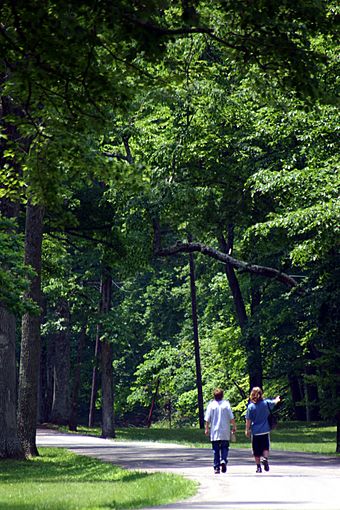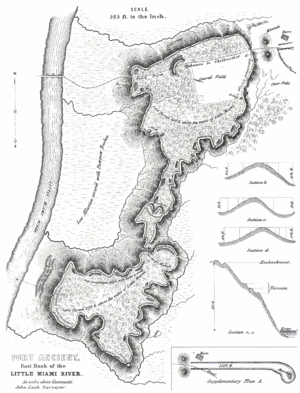Fort Ancient (Lebanon, Ohio) facts for kids
Quick facts for kids |
|
|
Fort Ancient
|
|

Nearly two miles of trails wind through Fort Ancient State Memorial's 764 acres (3.09 km2)
|
|
| Lua error in Module:Location_map at line 420: attempt to index field 'wikibase' (a nil value). | |
| Nearest city | Lebanon, Ohio |
|---|---|
| NRHP reference No. | 66000625 |
| Added to NRHP | October 15, 1966 |
Fort Ancient is a huge set of ancient earth walls built by Native Americans. You can find it in Warren County, Ohio, right by the Little Miami River. It's about 7 miles (11 km) southeast of Lebanon, Ohio.
This amazing place is the biggest prehistoric hilltop enclosure in the United States. Its walls stretch for three and a half miles (5.6 km) and cover about 100 acres (40 hectares)! The Hopewell culture built these earthworks. They lived in the area between 200 BC and AD 400. The site sits on a wooded hill, 270 feet (82 meters) above the Little Miami River.
Fort Ancient is so important that it's a National Historic Landmark. The State of Ohio bought the land in 1891, making it Ohio's very first state park. In September 2023, Fort Ancient became a World Heritage Site. It joined other important earthworks like those at Hopewell Culture National Historical Park and the Newark Earthworks.
Contents
Building the Earthworks
How Fort Ancient Was Made
The people of the Hopewell culture built the Fort Ancient earthworks over a long time. It took them about 400 years, in at least three different stages. Imagine building something that takes centuries!
They didn't have modern tools. Instead, they used things from nature. They used deer shoulder blades, split elk antlers, clam shells, and digging sticks to loosen the dirt. Then, they carried the soil in baskets. Each basket could hold about 35 to 40 pounds (16 to 18 kg) of earth. Experts believe they moved a massive amount of dirt, about 553,000 cubic yards (423,000 cubic meters) in total!
Exploring Fort Ancient's Past
Early Discoveries at the Site
People have been interested in Fort Ancient for a long time. The first map and description of the site were published way back in 1809. Later, in 1843, a man named John Locke surveyed the site.
In a famous book called Ancient Monuments of the Mississippi Valley, published in 1848, Fort Ancient was described as one of the largest ancient sites in the entire western United States. Many archaeologists have studied the site over the years to learn its secrets.
What Archaeologists Found
Archaeologists have done a lot of digging and research at Fort Ancient. They found that the big walls were built in many layers. They also found evidence of posts and structures at the base of the walls.
One interesting discovery was a three-level limestone pavement outside the earthworks. It showed signs of daily life, like cooking and other household activities. In another area, they found evidence of ten different homes inside the North Fort section. These discoveries help us understand how the Hopewell people lived and worked.
Why Was Fort Ancient Built?

More Than Just a Fort
When Fort Ancient was first discovered, some people thought it was a fort to protect against enemies. But archaeologists now believe it had a different purpose. There are a few reasons why it probably wasn't just for defense:
- The ditches are inside the walls, not outside. This would make it harder to defend.
- There are 84 openings, or gateways, in the walls. These would be very hard to protect during an attack.
- They haven't found enough evidence of a large population that would be needed for a big defense force.
A Place for Community and Stars
Today, most experts think the walls were built for social, economic, political, and ceremonial reasons. It was a place for the community to gather, trade, and hold important events.
Scientists have also found that the way the site is built lines up with important events in the sky. In the northeast part of the complex, there are four circular mounds covered with stones. One of these mounds seems to have been used to mark special times, like when the sun or moon reached certain points in the sky. This shows how connected the Hopewell people were to the natural world and the stars.
Visiting Fort Ancient Today
The Fort Ancient Museum
Today, Fort Ancient has a modern museum that covers 9,000 square feet (836 square meters). It teaches visitors about 1,500 years of Native American history in the Ohio Valley. You can learn about the first people in North America, how farming developed, and what happened when Europeans arrived. The museum also has a classroom, a research area, and a gift shop. It's open to the public from Wednesday to Saturday, 10:00 AM to 5:00 PM, and on Sundays from 12:00 PM to 5:00 PM.
The Historic Village Area
In the 1800s and early 1900s, a small village existed at the base of the earthworks, along the Little Miami River. It had a post office, a hotel, a blacksmith shop, and other businesses. The village is gone now, but the area is still used. You can find a canoe rental place and a private campground there.
A historic building called the Crossed Keys Tavern still stands on the west bank of the river. It was built in 1802 and is listed on the National Register of Historic Places. The area is also a public access point for the Little Miami Bike Trail, which follows the path of an old railroad.
See also

